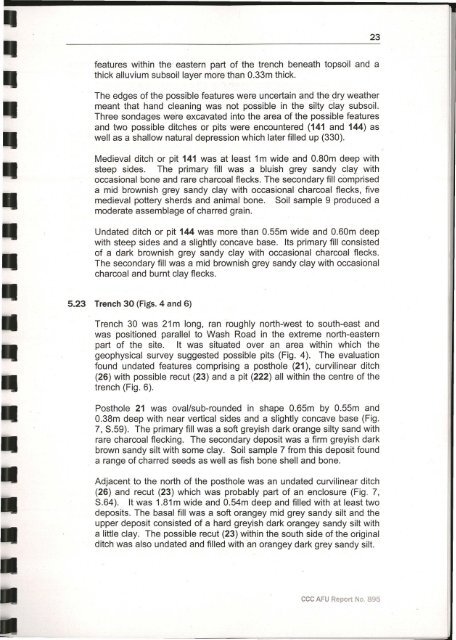fcambridgeshirearchaeology Late Saxon to Post-medieval Manorial ...
fcambridgeshirearchaeology Late Saxon to Post-medieval Manorial ...
fcambridgeshirearchaeology Late Saxon to Post-medieval Manorial ...
You also want an ePaper? Increase the reach of your titles
YUMPU automatically turns print PDFs into web optimized ePapers that Google loves.
features within the eastern part of the trench beneath <strong>to</strong>psoil and a<br />
thick alluvium subsoil layer more than 0.33m thick.<br />
The edges of the possible features were uncertain and the dry weather<br />
meant that hand cleaning was not possible in the silty clay subsoil.<br />
Three sondages were excavated in<strong>to</strong> the area of the possible features<br />
and two possible ditches or pits were encountered (141 and 144) as<br />
well as a shallow natural depression which later filled up (330).<br />
Medieval ditch or pit 141 was at least 1m wide and 0.80m deep with<br />
steep sides. The primary fill was a bluish grey sandy clay with<br />
occasional bone and rare charcoal flecks. The secondary fill comprised<br />
a mid brownish grey sandy clay with occasional charcoal flecks, five<br />
<strong>medieval</strong> pottery sherds and animal bone. Soil sample 9 produced a<br />
moderate assemblage of charred grain.<br />
Undated ditch or pit 144 was more than 0.55m wide and 0.60m deep<br />
with steep sides and a slightly concave base. Its primary fill consisted<br />
of a dark brownish grey sandy clay with occasional charcoal flecks.<br />
The secondary fill was a mid brownish grey sandy clay with occasional<br />
charcoal and burnt clay flecks.<br />
5.23 Trench 30 (Figs. 4 and 6)<br />
Trench 30 was 21m long, ran roughly north-west <strong>to</strong> south-east and<br />
was positioned parallel <strong>to</strong> Wash Road in the extreme north-eastern<br />
part of the site. It was situated over an area within which the<br />
geophysical survey suggested possible pits (Fig. 4). The evaluation<br />
found undated features comprising a posthole (21), curvilinear ditch<br />
(26) with possible recut (23) and a pit (222) all within the centre of the<br />
trench (Fig. 6).<br />
<strong>Post</strong>hole 21 was oval/sub-rounded in shape 0.65m by 0.55m and<br />
0.38m deep with near vertical sides and a slightly concave base (Fig.<br />
7, S.59). The primary fill was a soft greyish dark orange silty sand with<br />
rare charcoal flecking. The secondary deposit was a firm greyish dark<br />
brown sandy silt with some clay. Soil sample 7 from this deposit found<br />
a range of charred seeds as well as fish bone shell and bone.<br />
Adjacent <strong>to</strong> the north of the posthole was an undated curvilinear ditch<br />
(26) and recut (23) which was probably part of an enclosure (Fig. 7,<br />
S.64). It was 1.81m wide and 0.54m deep and filled with at least two<br />
deposits. The basal fill was a soft orangey mid grey sandy silt and the<br />
upper deposit consisted of a hard greyish dark orangey sandy silt with<br />
a little clay. The possible recut (23) within the south side of the original<br />
ditch was also undated and filled with an orangey dark grey sandy silt.<br />
23<br />
CCC AFU Report No. 895

















